The Ultrapycnometer Market is estimated to be valued at USD 52.8 million in 2025 and is projected to reach USD 90.1 million by 2035, registering a compound annual growth rate (CAGR) of 5.5% over the forecast period.
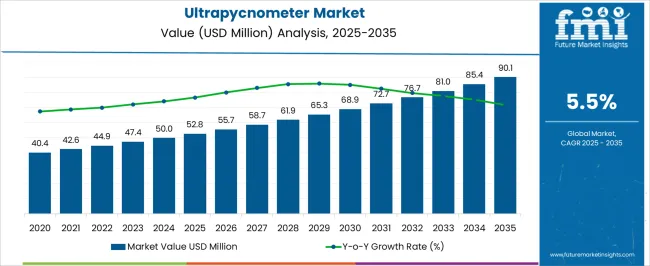
| Metric | Value |
|---|---|
| Ultrapycnometer Market Estimated Value in (2025 E) | USD 52.8 million |
| Ultrapycnometer Market Forecast Value in (2035 F) | USD 90.1 million |
| Forecast CAGR (2025 to 2035) | 5.5% |
The Ultrapycnometer market is experiencing steady growth as demand rises for precise density measurement solutions across industries such as pharmaceuticals, materials testing, and research laboratories. The current market scenario reflects increasing adoption of automated and software-enhanced instruments that enable faster, more accurate, and reproducible results compared to traditional methods. Growth is being supported by the rising emphasis on quality control, regulatory compliance, and process optimization in manufacturing and research settings.
Investments in R&D and laboratory infrastructure, particularly in regions with expanding pharmaceutical and material science sectors, are creating opportunities for advanced ultrapycnometer solutions. The market outlook remains positive as manufacturers continue to innovate with features such as automation, integration with data analytics, and improved sample handling capabilities.
Increasing focus on standardization and the adoption of high-precision instruments is expected to sustain market expansion, while end-users seek equipment that reduces human error and improves throughput in critical testing environments As demand for reliable material characterization grows, the ultrapycnometer market is anticipated to maintain a strong trajectory in both established and emerging markets.
The ultrapycnometer market is segmented by testing material, mode of operations, end use, and geographic regions. By testing material, ultrapycnometer market is divided into Solid, Liquid, and Gas. In terms of mode of operations, ultrapycnometer market is classified into Automatic and Semi-Automatic. Based on end use, ultrapycnometer market is segmented into Pharmaceuticals, Food Additives, Oil & Gas, Cosmetics, Construction, Institutional, and Others. Regionally, the ultrapycnometer industry is classified into North America, Latin America, Western Europe, Eastern Europe, Balkan & Baltic Countries, Russia & Belarus, Central Asia, East Asia, South Asia & Pacific, and the Middle East & Africa.
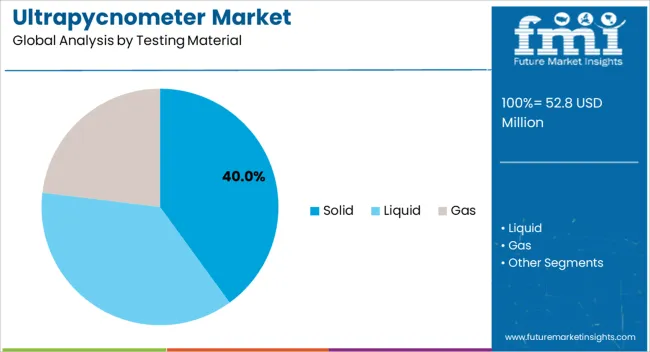
The solid testing material segment is projected to hold 40.00% of the Ultrapycnometer market revenue in 2025, making it the leading material category. Growth in this segment is being driven by the widespread requirement for density measurements of powders, granules, and compacted solids in quality assurance processes.
The preference for solid materials has been reinforced by the need to maintain stringent compliance with industry standards, particularly in pharmaceutical production and advanced materials development. Adoption has been facilitated by the compatibility of ultrapycnometers with a range of solid materials, allowing rapid and precise determination of true density and porosity without extensive sample preparation.
The segment’s expansion has also been supported by research and laboratory institutions that rely on solid material testing for formulation optimization and comparative studies As industries continue to emphasize product quality, efficiency, and regulatory adherence, the solid material category is expected to remain the primary revenue contributor within the market.
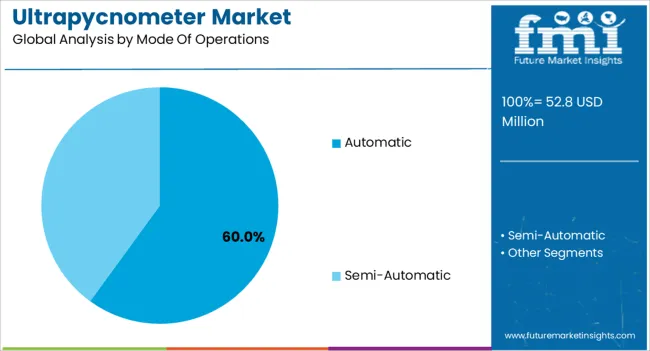
The automatic mode of operations segment is anticipated to capture 60.00% of the Ultrapycnometer market revenue in 2025, making it the most significant operational category. This leading position is being attributed to the growing demand for automation in laboratory and industrial testing environments. Automatic ultrapycnometers provide enhanced reproducibility, reduce manual errors, and increase throughput, which is essential for high-volume production and research applications.
Adoption has been reinforced by the ease of integration with digital monitoring systems and data analytics platforms, enabling seamless reporting and process optimization. Automation also allows for minimal operator intervention, reducing labor costs and improving safety, particularly when testing hazardous or sensitive materials.
The preference for automatic operation is expected to continue as laboratories and production facilities prioritize efficiency, accuracy, and compliance with regulatory standards The segment is likely to see sustained growth as industries increasingly adopt intelligent laboratory equipment capable of handling complex workflows with minimal human oversight.
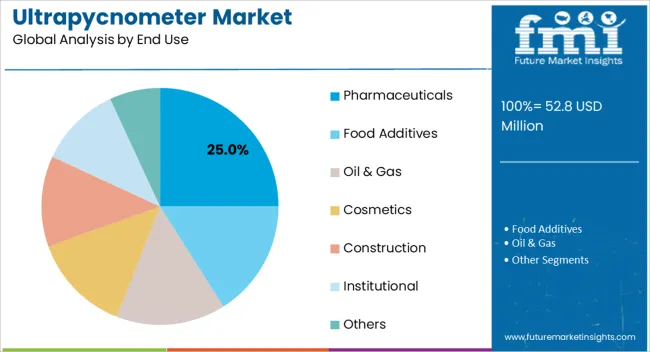
The pharmaceutical end-use segment is projected to hold 25.00% of the Ultrapycnometer market revenue in 2025, establishing it as the leading industry application. Growth in this segment is being driven by the critical need for precise density and porosity measurements during drug formulation, quality control, and regulatory compliance testing.
Pharmaceutical companies rely on ultrapycnometers to optimize active ingredient concentrations, excipient compatibility, and tablet compaction processes, ensuring consistent product performance and safety. Adoption has been further encouraged by the increasing focus on process analytical technology and quality by design approaches, which emphasize accurate material characterization throughout the drug development lifecycle.
Regulatory standards demand precise measurement of pharmaceutical solids, reinforcing the importance of ultrapycnometers in manufacturing and laboratory environments As the global pharmaceutical sector expands and product complexity increases, the use of high-precision density measurement equipment is expected to remain essential, sustaining the market leadership of this end-use segment in the ultrapycnometer industry.
The ultrapycnometer market is segmented by testing material, mode of operations, end use, and geographic regions. By testing material, ultrapycnometer market is divided into Solid, Liquid, and Gas. In terms of mode of operations, ultrapycnometer market is classified into Automatic and Semi-Automatic. Based on end use, ultrapycnometer market is segmented into Pharmaceuticals, Food Additives, Oil & Gas, Cosmetics, Construction, Institutional, and Others. Regionally, the ultrapycnometer industry is classified into North America, Latin America, Western Europe, Eastern Europe, Balkan & Baltic Countries, Russia & Belarus, Central Asia, East Asia, South Asia & Pacific, and the Middle East & Africa.
The solid testing material segment is projected to hold 40.00% of the Ultrapycnometer market revenue in 2025, making it the leading material category. Growth in this segment is being driven by the widespread requirement for density measurements of powders, granules, and compacted solids in quality assurance processes.
The preference for solid materials has been reinforced by the need to maintain stringent compliance with industry standards, particularly in pharmaceutical production and advanced materials development. Adoption has been facilitated by the compatibility of ultrapycnometers with a range of solid materials, allowing rapid and precise determination of true density and porosity without extensive sample preparation.
The segment’s expansion has also been supported by research and laboratory institutions that rely on solid material testing for formulation optimization and comparative studies As industries continue to emphasize product quality, efficiency, and regulatory adherence, the solid material category is expected to remain the primary revenue contributor within the market.
The automatic mode of operations segment is anticipated to capture 60.00% of the Ultrapycnometer market revenue in 2025, making it the most significant operational category. This leading position is being attributed to the growing demand for automation in laboratory and industrial testing environments. Automatic ultrapycnometers provide enhanced reproducibility, reduce manual errors, and increase throughput, which is essential for high-volume production and research applications.
Adoption has been reinforced by the ease of integration with digital monitoring systems and data analytics platforms, enabling seamless reporting and process optimization. Automation also allows for minimal operator intervention, reducing labor costs and improving safety, particularly when testing hazardous or sensitive materials.
The preference for automatic operation is expected to continue as laboratories and production facilities prioritize efficiency, accuracy, and compliance with regulatory standards The segment is likely to see sustained growth as industries increasingly adopt intelligent laboratory equipment capable of handling complex workflows with minimal human oversight.
The pharmaceutical end-use segment is projected to hold 25.00% of the Ultrapycnometer market revenue in 2025, establishing it as the leading industry application. Growth in this segment is being driven by the critical need for precise density and porosity measurements during drug formulation, quality control, and regulatory compliance testing.
Pharmaceutical companies rely on ultrapycnometers to optimize active ingredient concentrations, excipient compatibility, and tablet compaction processes, ensuring consistent product performance and safety. Adoption has been further encouraged by the increasing focus on process analytical technology and quality by design approaches, which emphasize accurate material characterization throughout the drug development lifecycle.
Regulatory standards demand precise measurement of pharmaceutical solids, reinforcing the importance of ultrapycnometers in manufacturing and laboratory environments As the global pharmaceutical sector expands and product complexity increases, the use of high-precision density measurement equipment is expected to remain essential, sustaining the market leadership of this end-use segment in the ultrapycnometer industry.
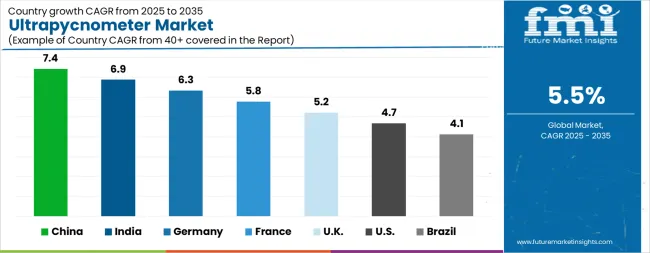
| Country | CAGR |
|---|---|
| China | 7.4% |
| India | 6.9% |
| Germany | 6.3% |
| France | 5.8% |
| UK | 5.2% |
| USA | 4.7% |
| Brazil | 4.1% |
The Ultrapycnometer Market is expected to register a CAGR of 5.5% during the forecast period, exhibiting varied country level momentum. China leads with the highest CAGR of 7.4%, followed by India at 6.9%. Developed markets such as Germany, France, and the UL continue to expand steadily, while the USA is likely to grow at consistent rates. Brazil posts the lowest CAGR at 4.1%, yet still underscores a broadly positive trajectory for the global Ultrapycnometer Market. In 2024, Germany held a dominant revenue in the Western Europe market and is expected to grow with a CAGR of 6.3%. The USA Ultrapycnometer Market is estimated to be valued at USD 18.7 million in 2025 and is anticipated to reach a valuation of USD 29.6 million by 2035. Sales are projected to rise at a CAGR of 4.7% over the forecast period between 2025 and 2035. While Japan and South Korea markets are estimated to be valued at USD 2.4 million and USD 1.6 million respectively in 2025.
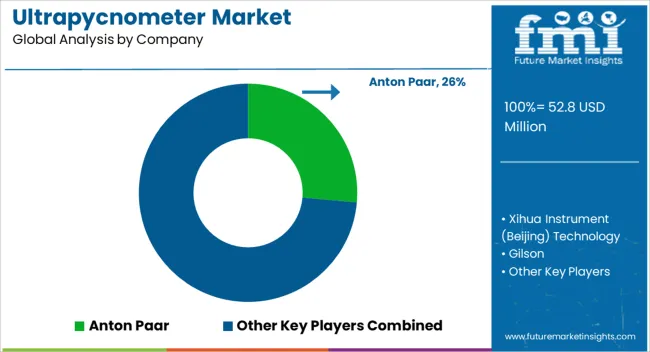
| Item | Value |
|---|---|
| Quantitative Units | USD 52.8 Million |
| Testing Material | Solid, Liquid, and Gas |
| Mode Of Operations | Automatic and Semi-Automatic |
| End Use | Pharmaceuticals, Food Additives, Oil & Gas, Cosmetics, Construction, Institutional, and Others |
| Regions Covered | North America, Europe, Asia-Pacific, Latin America, Middle East & Africa |
| Country Covered | United States, Canada, Germany, France, United Kingdom, China, Japan, India, Brazil, South Africa |
| Key Companies Profiled | Anton Paar, Xihua Instrument (Beijing) Technology, Gilson, Mettler-Toledo, Sartorius, Bentley & Associates, LLC, and PARALAB |
The global ultrapycnometer market is estimated to be valued at USD 52.8 million in 2025.
The market size for the ultrapycnometer market is projected to reach USD 90.1 million by 2035.
The ultrapycnometer market is expected to grow at a 5.5% CAGR between 2025 and 2035.
The key product types in ultrapycnometer market are solid, liquid and gas.
In terms of mode of operations, automatic segment to command 60.0% share in the ultrapycnometer market in 2025.






Our Research Products

The "Full Research Suite" delivers actionable market intel, deep dives on markets or technologies, so clients act faster, cut risk, and unlock growth.

The Leaderboard benchmarks and ranks top vendors, classifying them as Established Leaders, Leading Challengers, or Disruptors & Challengers.

Locates where complements amplify value and substitutes erode it, forecasting net impact by horizon

We deliver granular, decision-grade intel: market sizing, 5-year forecasts, pricing, adoption, usage, revenue, and operational KPIs—plus competitor tracking, regulation, and value chains—across 60 countries broadly.

Spot the shifts before they hit your P&L. We track inflection points, adoption curves, pricing moves, and ecosystem plays to show where demand is heading, why it is changing, and what to do next across high-growth markets and disruptive tech

Real-time reads of user behavior. We track shifting priorities, perceptions of today’s and next-gen services, and provider experience, then pace how fast tech moves from trial to adoption, blending buyer, consumer, and channel inputs with social signals (#WhySwitch, #UX).

Partner with our analyst team to build a custom report designed around your business priorities. From analysing market trends to assessing competitors or crafting bespoke datasets, we tailor insights to your needs.
Supplier Intelligence
Discovery & Profiling
Capacity & Footprint
Performance & Risk
Compliance & Governance
Commercial Readiness
Who Supplies Whom
Scorecards & Shortlists
Playbooks & Docs
Category Intelligence
Definition & Scope
Demand & Use Cases
Cost Drivers
Market Structure
Supply Chain Map
Trade & Policy
Operating Norms
Deliverables
Buyer Intelligence
Account Basics
Spend & Scope
Procurement Model
Vendor Requirements
Terms & Policies
Entry Strategy
Pain Points & Triggers
Outputs
Pricing Analysis
Benchmarks
Trends
Should-Cost
Indexation
Landed Cost
Commercial Terms
Deliverables
Brand Analysis
Positioning & Value Prop
Share & Presence
Customer Evidence
Go-to-Market
Digital & Reputation
Compliance & Trust
KPIs & Gaps
Outputs
Full Research Suite comprises of:
Market outlook & trends analysis
Interviews & case studies
Strategic recommendations
Vendor profiles & capabilities analysis
5-year forecasts
8 regions and 60+ country-level data splits
Market segment data splits
12 months of continuous data updates
DELIVERED AS:
PDF EXCEL ONLINE
Video Extensometer Market Size and Share Forecast Outlook 2025 to 2035
Fluorescence Spectrophotometer Market Size and Share Forecast Outlook 2025 to 2035
Laboratory Grinders Market Size and Share Forecast Outlook 2025 to 2035
Automated Biochemical Analyzer Market Size and Share Forecast Outlook 2025 to 2035
Vapor Pressure Analyzer Market Size and Share Forecast Outlook 2025 to 2035
Global PP Closure Market Size and Share Forecast Outlook 2025 to 2035
Global Positioning Systems Market Size and Share Forecast Outlook 2025 to 2035
Global Glycidol Market Size and Share Forecast Outlook 2025 to 2035
Global Tert-Amylbenzene Market Size and Share Forecast Outlook 2025 to 2035
Global Sodium Hypochlorite Market Size and Share Forecast Outlook 2025 to 2035
Global Stannic Chloride Market
Global Tyre Inflators Market
Global Wine Tanks Market
Global Bench Scale Market
Global Nutating Mixers Market
Global HVAC Filter Market
Global Nitrite Market
Global Optical Comparator Market
Global Loaders Market
Global Aircraft Brake System Market

Thank you!
You will receive an email from our Business Development Manager. Please be sure to check your SPAM/JUNK folder too.
Chat With
MaRIA